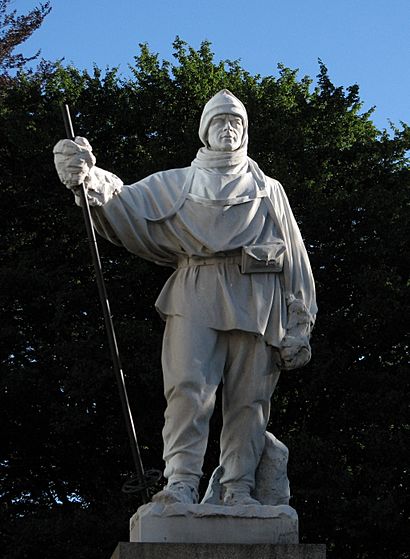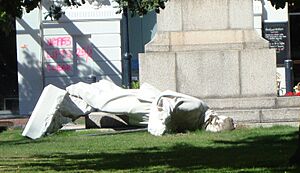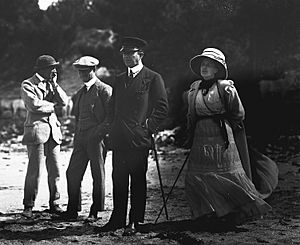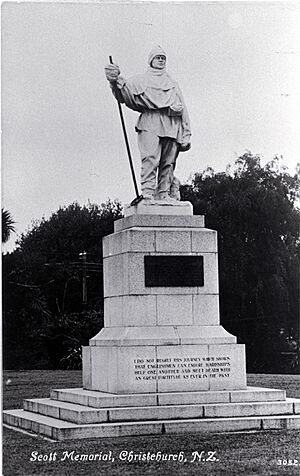Statue of Robert Falcon Scott, Christchurch facts for kids
Quick facts for kids Statue of Robert Falcon Scott |
|
|---|---|

Scott Statue in Christchurch, New Zealand, sculpted by his widow Kathleen Scott
|
|
| Artist | Kathleen Scott |
| Year | 1916 |
| Catalogue | 1840 |
| Medium | Marble |
| Subject | Robert Falcon Scott |
| Designation | Category II historic place |
| Location | Oxford Terrace and Worcester Street, Christchurch |
| 43°31′52″S 172°38′01″E / 43.53120°S 172.63361°E | |
The Scott Statue is a special monument in Christchurch Central City, New Zealand. It honors a famous explorer named Robert Falcon Scott. His wife, Kathleen Scott, carved the statue herself. It stands where Oxford Terrace and Worcester Street meet. This statue is recognized as a Category II historic place. In 2011, a big earthquake hit Christchurch. The statue fell and broke in half. It was later put back together and returned to its spot in October 2017.
Contents
Who Was Robert Falcon Scott?
Robert Falcon Scott was a brave explorer. He led trips to Antarctica, the coldest place on Earth. Christchurch and Lyttelton were important places for him. He used them as his base in New Zealand for his expeditions.
Scott's Antarctic Journeys
Scott led two major trips to Antarctica. The first was the British National Antarctic Expedition (1901–1904). His second trip was the Terra Nova Expedition (1910–1913). The main goal of this second trip was to be the first to reach the South Pole.
Scott and four friends reached the South Pole on January 17, 1912. But they found out that a Norwegian team, led by Roald Amundsen, had gotten there 33 days before them. Sadly, Scott and his entire team died on their way back from the pole. Because of their bravery and tragic end, they were seen as heroes across the British Empire.
Remembering the Explorers
After the news of Scott's team reached the world, people wanted to remember them. Many memorials were set up. An oak tree was planted in the street where the news first arrived. Stone tablets were placed on a boulder in Queenstown Gardens. A memorial was also built in Port Chalmers, the last port the Terra Nova ship visited before heading to Antarctica.
How the Scott Statue Was Made
Soon after Scott's death, the Mayor of Christchurch, Henry Holland, asked people to help create a memorial. A group was formed, and they raised over £1,000. They asked Scott's wife, Kathleen, what she thought. This led to her being asked to sculpt a statue of her husband.
Choosing the Material
Kathleen Scott was asked to make a copy of a bronze statue of her husband in London. But during World War I, metal became very expensive. So, they decided to use marble instead. Marble was a more affordable choice at the time.
Kathleen went to Carrara, Italy, in March 1916 to carve the statue. This was because Britain had banned importing marble. She was happy with the marble block she found. She said it was "a remarkably fine piece of marble, of a good colour and without any flaw whatever."
Unveiling the Statue
The statue was finished in April 1916. But because of the war, it wasn't shipped until October. The Governor-General of New Zealand, The Earl of Liverpool, officially revealed the statue. This happened on February 9, 1917. It was placed at the corner of Worcester Street and Oxford Terrace. It faced north, looking towards the old city offices.
The statue's base has a special message. It's from one of Scott's last diary entries:
I do not regret this journey, which shows
that Englishmen can endure hardships,
help one another, and meet death with
as great fortitude as ever in the past.
By 1922, this message was hard to read. So, a separate marble plaque with the same words was added nearby. Another plaque lists the names of the five men who died. Later, in 1998, another plaque was added to honor Kathleen Scott, the sculptor. It reads:
This statue was sculpted by Kathleen Scott FRSBS (1878–1947) Widow of Captain Scott, and was unveiled in 1917.
Unfinished Details
The statue was not completely finished. Some details on the gloves were not done. Also, one of the legs rests against a stump for support. Kathleen Scott had offered to finish these details if she returned to Christchurch, but she never did.
The Statue and the Earthquake

In February 2011, a big earthquake hit Christchurch. The Scott Statue fell off its base and broke into two pieces. It was then stored away for safety.
Later, the broken statue was put on display. It was shown during the Icefest in November 2012. From January 2016, it was part of Christchurch's Earthquake Museum. This museum is part of the Canterbury Museum in City Mall. Finally, in October 2017, the repaired statue was put back in its original spot.



